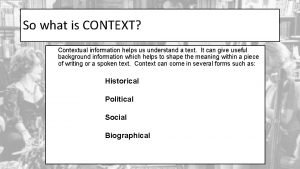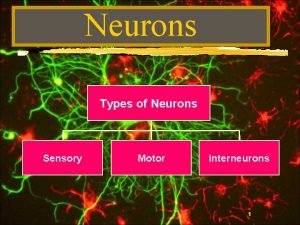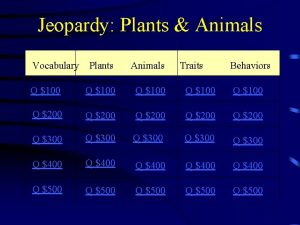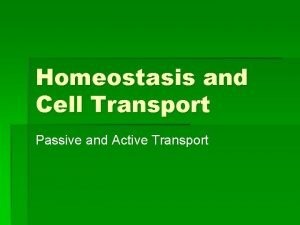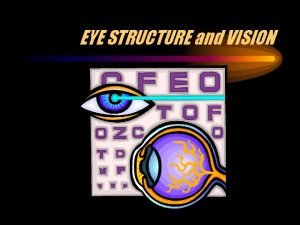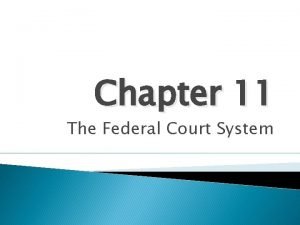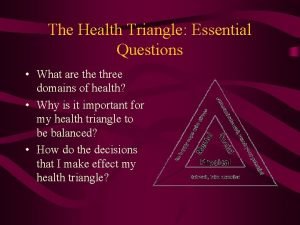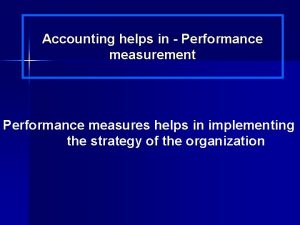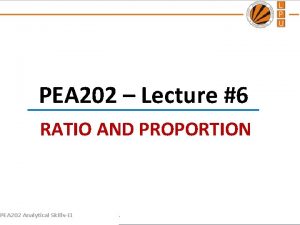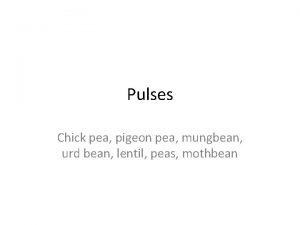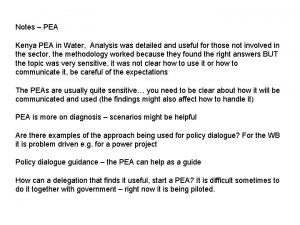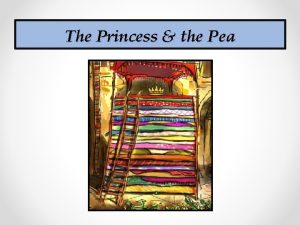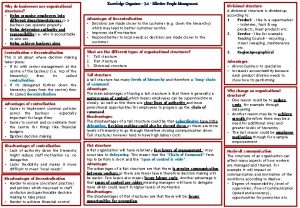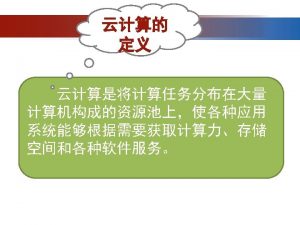PEA Why use PEA 1 It helps to













- Slides: 13

PEA

Why use PEA? 1. It helps to structure your answer 2. Writing a detailed analysis can help you achieve a “C” grade

What is PEA? P = point E = evidence A = analysis

When should you use PEAS? 1. In your exam, when answering questions 2, 3, 4 and 5 2. When you have been asked to focus on language and presentational devices 3. When writing about the effect created on the reader and/or the writer’s point of view.

Point 1. Writing a point is pretty simple. All you have to do is make sure you answer the question 2. You can do this by recycling the question and turning it into a statement So if the question is: How does the writer feel in the article? You will begin your point by writing: In the given article, the writer feels. . .

Evidence 1. This requires you to prove your point by giving a quote from the text 2. Make your quote as short and focused as possible 3. Introduce your quote by writing. . . - for example it states. . . - this is evident when. . . - for instance. . .

Evidence 1. Selecting relevant evidence is important 2. Question 1 of the exam paper will ask you to select relevant information. If you do it correctly, you get 4 easy marks 3. To get a “C”, you need to show the examiner that you can use relevant and appropriate evidence 4. The more focused your evidence, the more relevant and appropriate it is. Only use the words/phrases which prove your point.

The Analysis Process Evidence: “Johnny felt trapped in a never-ending nightmare”. 1. Ask your self what does the evidence suggest – it suggests that Johnny is perhaps scared or frightened 2. Ask yourself what the key words (words that stand out to you) are – the key words are: trapped, never-ending, nightmare 3. Ask yourself what the keywords suggest – - Trapped: stuck, alone, isolated, - Never-ending: forever, no escape - Nightmare: something you want to wake up from, a dream, unreal, something you want to stop.

Analysis 1. Write about the language the writer has used 2. Start your analysis with “This suggests that. . . ”. In this sentence you can write what the quote shows about the writer’s point of view or how the reader is made to feel (one sentence is enough) 3. Then, you identify key words from the evidence (these are the words that stand out to you) and you explore what they suggest in detail about the writer’s point of view or how the reader is made to feel. • Have a look at the step by step process on the next slide!

Example of a Good Analysis • Now put all your ideas together! Your analysis should be at least three sentences long. • Evidence: “Johnny felt trapped in a never-ending nightmare”. • This suggests that Johnny is frightened. The writer has chosen the word “trapped” to show that Johnny is stuck and cannot escape from what is scaring him. He feels isolated and alone. He is living a nightmare that is described as “never-ending” and this could suggest he is hopeless as he feels that things will never get better. It seems as if the situation is unreal as a nightmare is something you have when you are dreaming, it is something you want to wake up from. The writer makes clear that Johnny is enduring this nightmare and the possibility of it stopping is very unlikely. The reader begins to feel uneasy as he/she begins to question what exactly is trapping Johnny and why it is that his entrapment appears “never-ending”.

How to get the best grade – Tip! 1. Providing a simple comment, such as “Johnny is frightened”, will get you no higher than an “E” 2. Providing some comment on the effects of key words, such as “Johnny is frightened. The writer has chosen the word “trapped” to show that Johnny is stuck and cannot escape from what is scaring him”, will get you no higher than a D 3. Analysing relevant key words and focusing in detail on what they suggest about the effect of the language on the reader or what it shows about the writer’s point of view, as shown in the last slide, will help you get a “C”.

Have a go – Write your own answer using PEA! Question – How are the characters feeling? “We moved forward carefully, arms outstretched, feeling forward with our feet before we took each step. Our breath was fast, shallow, trembly. My heart was thundering. I opened my eyes wide, glared into the dark, seeking the shape of his body on the floor. ”

How is this character feeling? I wanted to run, run away from this disgusting, gigantic and absurd man who reminded me of nothing less than a monster. He wouldn’t take his eyes of me. This ogre would not let me go. I tried slithering out of his grip, but his poisonous hand continued to grip me, harder and harder.
 Palam triloki is a variety of
Palam triloki is a variety of Hey bye bye
Hey bye bye What is context information
What is context information Dont ask
Dont ask It helps us understand people and societies
It helps us understand people and societies Putting a speech together in a particular way
Putting a speech together in a particular way Fatty casing that helps speed neurotransmission
Fatty casing that helps speed neurotransmission Mcdp-1 states that trust
Mcdp-1 states that trust Hibernation is an adaptation that helps animals to _______.
Hibernation is an adaptation that helps animals to _______. What can churches do to help the community
What can churches do to help the community Helps maintain homeostasis active or passive
Helps maintain homeostasis active or passive What helps maintain the eyeball's spherical shape
What helps maintain the eyeball's spherical shape The federal court system chapter 11 answer key
The federal court system chapter 11 answer key Physical health triangle
Physical health triangle


